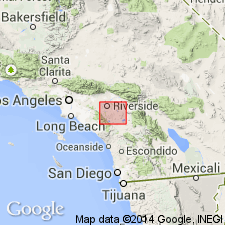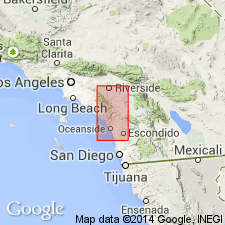
- Usage in publication:
-
- Cajalco quartz monzonite
- Modifications:
-
- Named
- Dominant lithology:
-
- Quartz monzonite
- AAPG geologic province:
-
- Peninsular Ranges province
Summary:
Named for occurrence between Monument Peak and Arlington Mountain, including Cajalco Canyon, Riverside Co, CA. Has coarse crystalline texture with flesh to pinkish orthoclase, prominent quartz and constant amount of biotite. Between Cajalco Tin Mine and Monument Peak a tourmalinized zone is present with dikes of nearly pure tourmaline present. Is younger than Steele Valley granodiorite (new). Intrudes Perris quartz diorite (new). Cajalco "is placed as latest of series because it is the most acid of the intrusive group". Is Late Jurassic(?) age.
Source: GNU records (USGS DDS-6; Menlo GNULEX).

- Usage in publication:
-
- Cajalco quartz monzonite
- Modifications:
-
- Not used
- AAPG geologic province:
-
- Peninsular Ranges province
Summary:
Rocks of Cajalco quartz monzonite of Dudley (1935) are included in Woodson Mountain granodiorite (new). Age of Woodson Mountain granodiorite is Cretaceous.
Source: GNU records (USGS DDS-6; Menlo GNULEX).
For more information, please contact Nancy Stamm, Geologic Names Committee Secretary.
Asterisk (*) indicates published by U.S. Geological Survey authors.
"No current usage" (†) implies that a name has been abandoned or has fallen into disuse. Former usage and, if known, replacement name given in parentheses ( ).
Slash (/) indicates name conflicts with nomenclatural guidelines (CSN, 1933; ACSN, 1961, 1970; NACSN, 1983, 2005, 2021). May be explained within brackets ([ ]).

